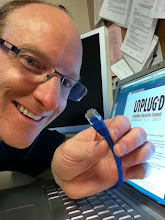
In our introduction to Connectivism, I smiled at finding direct parallels between the way information percolates through a human network; and the way it is thought to leap microscopic chasms in the human brain.
Networks on the Inside
I love John Medina's descriptive metaphor for physical learning in the brain:
Beginning with the realization that most cells look like fried eggs, Medina suggests how to turn it into a nerve cell, consisting of the cell body and dendrites: "Take that fried egg and smash it with your foot, splattering it across the floor. The resulting mess might look like a many-pointed star. Now take one tip of that star, and stretch it out. Way out. Using your thumb, now squish the farthest region of the point you just stretched. This creates a smaller version of that multipronged shape. Two smashed stars separated by a long, thin line. There's your typical nerve."
The connections between neurons in an "underwater forest" are as if the roots of trees have been jammed together... and "usually, thousands of neurons are jammed up against one another..."
 After an "Fantastic Voyage" description of cell communication, Medina goes on to explain what learning might resemble: "Like snakes swaying to the rhythm of some chemical flute, some of these branches appear to be moving. Occasionally, the end of one neuron swells up, greatly increasing in diameter. The terminal ends of other neurons split down the middle like a forked tongue, creating two connections where there was only one. Electricity crackles through these moving neurons at a blinding 250 miles per hour, some quite near us, with clouds o f neurotransmitters filling the spaces between the trunks as the electric current passes by."
After an "Fantastic Voyage" description of cell communication, Medina goes on to explain what learning might resemble: "Like snakes swaying to the rhythm of some chemical flute, some of these branches appear to be moving. Occasionally, the end of one neuron swells up, greatly increasing in diameter. The terminal ends of other neurons split down the middle like a forked tongue, creating two connections where there was only one. Electricity crackles through these moving neurons at a blinding 250 miles per hour, some quite near us, with clouds o f neurotransmitters filling the spaces between the trunks as the electric current passes by."Networks on the Outside
With each of us playing the part of a neuron in a much larger though less interconnected network, I'm sure many see parallels with the idea of being squashed, and stretched thin; but the reality is that we too are communicating in networks without coming in physical contact with one another. Information traverses the distances between human nodes by eerily similar electronic impulses. The branches of our networks are likely as intertwined as are our neurons, with only a few degrees of separation dividing any two networked educators.
Learning networks continually experience expansion, pruning, adaptation and rewiring as less useful nodes are abandoned for the fresh ideas of new individuals who energize online discussions. The idea that nodes of influence can become energized and multiply via RSS and hyperlinking, acts as a direct parallel to actions of energized neurons who split and reach out in new directions in Medina's explanation of learning. The new connections that result, are evidence of learning, not only on the part of individual, but on the part of the network itself.
Networks on My Mind
With my current professional role in e-learning, I've experienced the reality that the human connections are in fact more valuable than any idea or resource that might be shared within a group. As connectivist ideas continue to invade my interior network, I'm finding that same bundle of neurons to be the best aid in comprehending connectivist frameworks.
References:
Medina, J. J. (2008). Brain Rules: 12 Principles for Surviving and Thriving at Work, Home, and School. Seattle, Washington: Pear Press.
Photo Credits: GustavoG; Lorelei Ranveig




2 comments:
I really like the way you explained this. I have a computer network in my brain that is mapping to this whole idea of connected networks for learning, but I wish I could put it into words like you have.
Although words are a foreign way to represent this idea of networking... the process of writing is helping me get my head around this whole model of learning.
That rhizome over on your blog looks a lot like a wandering brain? It's quite an image!
Post a Comment